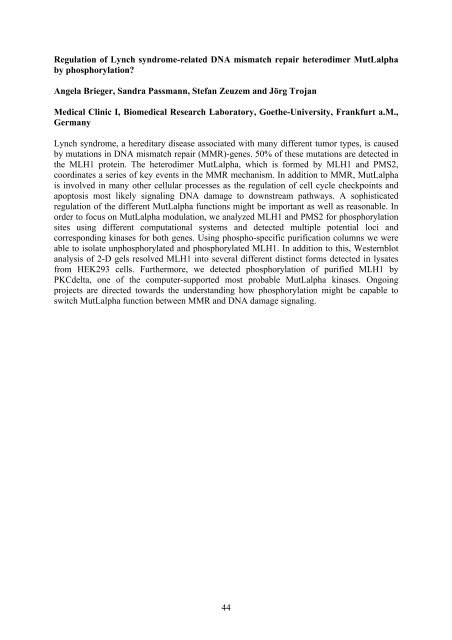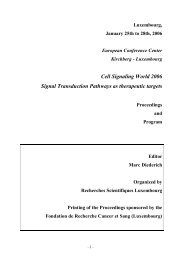Abstract book (download .pdf file) - Redox and Inflammation ...
Abstract book (download .pdf file) - Redox and Inflammation ...
Abstract book (download .pdf file) - Redox and Inflammation ...
You also want an ePaper? Increase the reach of your titles
YUMPU automatically turns print PDFs into web optimized ePapers that Google loves.
Regulation of Lynch syndrome-related DNA mismatch repair heterodimer MutLalpha<br />
by phosphorylation?<br />
Angela Brieger, S<strong>and</strong>ra Passmann, Stefan Zeuzem <strong>and</strong> Jörg Trojan<br />
Medical Clinic I, Biomedical Research Laboratory, Goethe-University, Frankfurt a.M.,<br />
Germany<br />
Lynch syndrome, a hereditary disease associated with many different tumor types, is caused<br />
by mutations in DNA mismatch repair (MMR)-genes. 50% of these mutations are detected in<br />
the MLH1 protein. The heterodimer MutLalpha, which is formed by MLH1 <strong>and</strong> PMS2,<br />
coordinates a series of key events in the MMR mechanism. In addition to MMR, MutLalpha<br />
is involved in many other cellular processes as the regulation of cell cycle checkpoints <strong>and</strong><br />
apoptosis most likely signaling DNA damage to downstream pathways. A sophisticated<br />
regulation of the different MutLalpha functions might be important as well as reasonable. In<br />
order to focus on MutLalpha modulation, we analyzed MLH1 <strong>and</strong> PMS2 for phosphorylation<br />
sites using different computational systems <strong>and</strong> detected multiple potential loci <strong>and</strong><br />
corresponding kinases for both genes. Using phospho-specific purification columns we were<br />
able to isolate unphosphorylated <strong>and</strong> phosphorylated MLH1. In addition to this, Westernblot<br />
analysis of 2-D gels resolved MLH1 into several different distinct forms detected in lysates<br />
from HEK293 cells. Furthermore, we detected phosphorylation of purified MLH1 by<br />
PKCdelta, one of the computer-supported most probable MutLalpha kinases. Ongoing<br />
projects are directed towards the underst<strong>and</strong>ing how phosphorylation might be capable to<br />
switch MutLalpha function between MMR <strong>and</strong> DNA damage signaling.<br />
44




